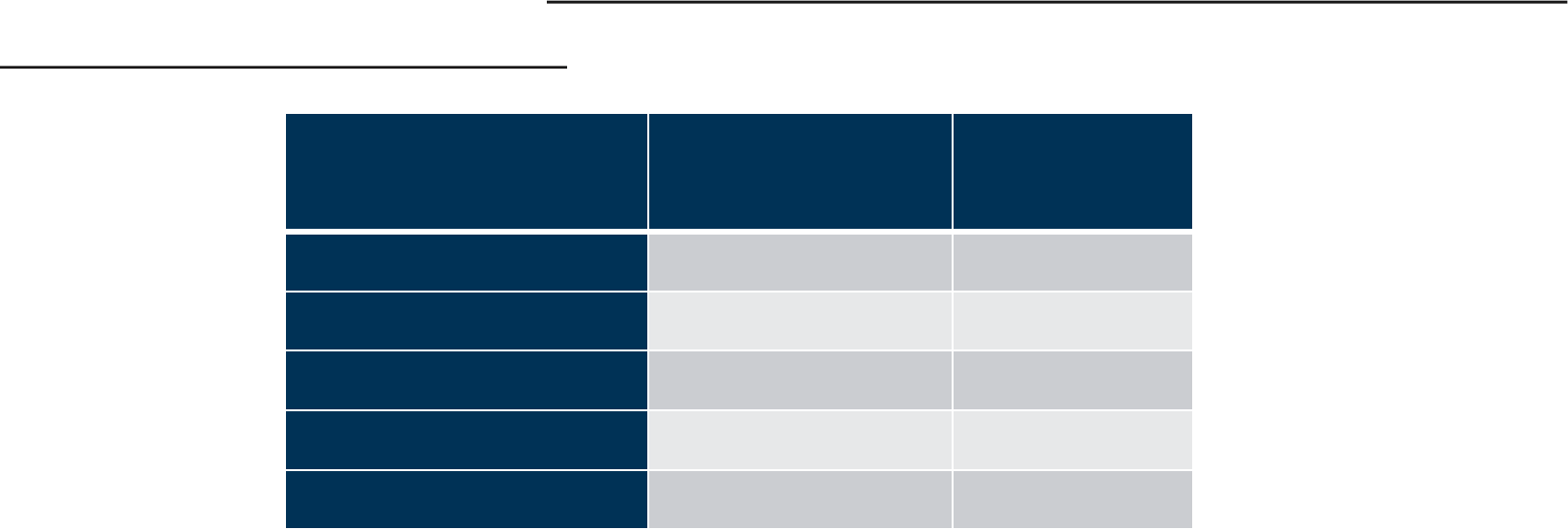
FEDERAL DEPOSIT INSURANCE CORPORATION
New Trust Account Rule (April 2024)
Deposit Insurance Seminar For Bankers
2022
Outline
Part Overview of New Trust Account Rule
Part 2 Examples of the New Trust Account Rule
Part 3 How the New Trust Account Rule Affects Coverage
Part 4 Complex Rules Eliminated
Part
5 Deposit Insurance Coverage Resources
2
Disclaimer
The information contained in this presentation is for informational purposes
only and is provided as a public service and in an effort to enhance
understanding of the statutes and regulations administered by the FDIC. It
expresses the views and opinions of FDIC staff and is not binding on the FDIC, its
Board of Directors, or any board member, and any representation to the
contrary is expressly disclaimed.
3

How To Access Today's Presentation Slide Deck
On the FDIC website at www.fdic.gov
In the search box in the upper right
hand corner, type in "webinars" and
press enter
Look for a link titled deposit
insurance banker webinars.
Once on the FDIC's banker webinars
page, scroll towards the middle of the
page and look for a header titled New
Rules for Revocable and Irrevocable
Trusts and click on it.
If you have any questions, please call
us at 1-877-275-3342.
https://ask.fdic.gov/fdicinformationandsupportcenter/s/
4

Seminar on Deposit Insurance Coverage
Part 1 – Overview of New Trust
Account Rule
5
Overview
On January 21, 2022, the FDIC adopted a new deposit insurance rule for “trust
accounts” that is easier for bankers and depositors to understand.
The new trust account rule does not go into effect until April 1, 2024.
The new rule simplifies insurance coverage for trust accounts by:
reducing the number of insurance rules for trust accounts;
eliminating complexities from the revocable and irrevocable trust rules; and
utilizing the same familiar, straightforward insurance calculation for both
revocable and irrevocable trusts.
6

Overview – Scope & Familiar Insurance Rule
Combines categories. The new trust account rule will combine the irrevocable
trust (§330.13) and revocable trust (§330.10) categories into a single category
called “Trust Accounts”. The new trust account category will include:
formal revocable trusts (§330.10);
informal revocable trusts (e.g., POD/ITF accounts from 330.10); and
irrevocable trusts (§330.13).
Familiar insurance rule. Under the Trust Account category, each trust owner will
be insured up to $250,000 per eligible primary beneficiary, up to a maximum of
five beneficiaries.
Similar to the current revocable trust rules, an “eligible” beneficiary can be any living
person or an IRS-recognized charity/non-profit. Only “primary” (not contingent)
beneficiaries count.
7

Overview – Familiar Insurance Rule
The new trust account insurance
calculation is the same calculation the
FDIC has used since 2008 for a revocable
trust with 5 or fewer beneficiaries.
In the new trust account category, each
trust owner’s insurance limit will be
determined by how many eligible
beneficiaries (up to 5) are in their trust(s).
For example, a trust owner with four
eligible, primary beneficiaries is insured
up to $1,000,000 (or 1 x 4 x $250k = $1M).
Number of
trust owners
Number of
beneficiaries
Insurance
limit
1 1 $250,000
1 2 $500,000
1 3 $750,000
1 4 $1,000,000
1 5 $1,250,000
1 5+ $1,250,000
8

Seminar on Deposit Insurance Coverage
Part 2 – Examples of the New
Trust Account Rule
9

Revocable Trust Example – 1 owner, 2 beneficiaries
Owner A
Beneficiary B
Beneficiary C
Owner A has opened a revocable trust account and identified two eligible
beneficiaries - B and C.
What is the maximum amount that can be insured under the current rule?
What is the maximum amount that can be insured under the new trust rule?
10

Revocable Trust Example – 1 owner, 2 beneficiaries
In this example, there is 1 trust owner
and 2 beneficiaries.
All of the owner’s deposit accounts are
titled in their revocable trust.
The insurance limit is $500,000
(1 x 2 x $250,000 = $500,000)
Number of trust
owners
Number of
beneficiaries
Insurance
limit
1 1 $250,000
1 2 $500,000
1 3 $750,000
1 4 $1,000,000
1 5 $1,250,000
1 5+ $1,250,000
In this example, the New Trust Rule uses the exact same insurance calculation that is
used under the current rules to determine the insurance limit.
11

Irrevocable Trust Example – 1 owner, 2 beneficiaries
Owner A
Beneficiary B
Beneficiary C
An irrevocable trust with one owner (A) identifies
two eligible beneficiaries - B and C.
What is the maximum amount that can be insured under the current rule?
What is the maximum amount that can be insured under the New Rule?
12

Irrevocable Trust Example – 1 owner, 2 beneficiaries
In this example, there is 1 trust owner
and 2 beneficiaries.
All of the owner’s deposit accounts are
titled in their irrevocable trust.
The insurance limit is
$500,000 (calculated as 1 x 2 x
$250,000 = $500,000).
Number of trust
owners
Number of
beneficiaries
Insurance
limit
1 1 $250,000
1 2 $500,000
1 3 $750,000
1 4 $1,000,000
1 5 $1,250,000
1 5+ $1,250,000
Under the new Trust Rule, insurance limits for irrevocable trusts will be calculated
the same as for revocable trusts. Also, the calculation for irrevocable trust will be
simplified.
13

Same trust owner has both revocable and irrevocable
trust accounts
A depositor is the sole grantor of both a revocable and irrevocable trust. All of
their bank accounts are titled as trust accounts. Some are titled in the name of the
irrevocable trust and some are titled in the name of the revocable trust.
What are the insurance limits under the current rules (revocable and
irrevoc
able)? What will the insurance limit be under the new trust rule?
Key facts: The revocable trust identifies 3 children as beneficiaries and the
irr
evocable trust names 2 grandchildren as beneficiaries.
Also, the irrevocable trust may have a grantor retained interest and it’s not clear if the
grandkids have ‘contingent’ or ‘non-contingent’ trust interests. A lawyer may be needed.
14

Same trust owner has both revocable and irrevocable
trust accounts at the same bank
Under the new trust rule, the insurance
limit with one owner and 5 or more
eligible beneficiaries will be up to
$1,250,000 per insured bank.
As long as the combined
balance of
their revocable and irrevocable trust
accounts is $1.25 million or less, the
depositor is fully insured.
Insurance for the irrevocable trust
portion will be easier to figure out
under the new trust rule.
Number of trust
owners
Number of
beneficiaries
Insurance
limit
1 1 $250,000
1 2 $500,000
1 3 $750,000
1 4 $1,000,000
1 5+ $1,250,000
15

Revocable Trust – 2 owners, 4 beneficiaries
Owner A
Owner B
Beneficiary C
Beneficiary D
Beneficiary E
Beneficiary F
Bank depositors – A and B – set up all of their deposit accounts as payable on
death to their two kids and two favorite charities (recognized by the IRS).
What will their insurance limit be un
der the new trust account rule?
16

Example – Revocable Trust Example – 2 owners, 4 beneficiaries
With 2 owners and 4 eligible
beneficiaries, the owners’ accounts
would be added together and the
combined balance insured up to
$2,000,000.
In this example, the New Trust Rule
uses the exact same insurance
calculation that is used today to figure
out the insurance limit: 2 owners x 4
eligible beneficiaries x $250,000.
Number of trust
owners
Number of
beneficiaries
Insurance
limit
2 1 $500,000
2 2 $1,000,000
2 3 $1,500,000
2 4 $2,000,000
2 5+ $2,500,000
17
Example Summary – Key Points
These examples used some simplifying assumptions
to help illustrate how insurance
limits
w
ill be calculated under the new trust account rule starting April 1, 2024.
Some depositors with more complicated account structures, e.g., depositors A and
B have co-owned trust accounts and in addition, Depositor A has some one-owner
trust accounts. Whether under the current rules or when the new rules are in effect,
if the account structure is complex, the analysis may be as well. Please contact us if
you need some assistance in determining your depositor's insurance coverage
As you saw in some examples, the current insurance rules and the new insurance rule
were exactly the same. As you will see in the next few slides, in other examples, the
new trust rule will be different.
18

Seminar on Deposit Insurance Coverage
Part 3 – How the New Trust Account Rule,
Affects Coverage
19

Depositors Whose Coverage Will Not Be Affected
A significant percentage of depositors will not be directly impacted by the
trust account insurance rule. For example:
Any depositor with a total deposit of $250,000 or less per bank.
Depositors with accounts in the other ownership categories:
New Trust Rules – Change to only Deposit Insurance Ownership Categories
Single Accounts (no beneficiaries) Public Bond Accounts
Joint Accounts (no beneficiaries) IDIs As Trustee of an Irrevocable Trust
Certain Retirement Accounts, e.g., IRAs Annuity Contract Accounts
Employee Benefit Plan Accounts Custodial Accounts for Native Americans
Corps., Partnerships and Unincorporated
Assoc.
Bank Accounts related to DOE Program
Government Accounts
* The Mortgage Servicing Account ownership category was amended as part of the simplification
rule FIL-07-2022
20

Depositors Whose Coverage Will Not Be Affected
Even for depositors with trust accounts – revocable or irrevocable – many
will not see a change in their insurance limit.
Example 1: A revocable trust owner who is fully insured under the current
revocable trust rules for
five or fewer beneficiaries will remain insured
under the new trust rules
. They have no irrevocable trusts on deposit.
Number of trust
owners
Number of
beneficiaries
Insurance
limit
1 1 $250,000
1 2 $500,000
1 3 $750,000
1 4 $1,000,000
1 5 $1,250,000
21

Depositors Whose Coverage Will Not Be Affected
Example 2: A revocable trust owner(s) with 6 or more eligible beneficiaries and is
currently insured up to $1.25 million. They have no irrevocable trusts. Under the
new rule, their coverage remains up to $1.25 million per owner, per bank.
Example 3: A revocable trust owner(s) with 6 or more eligible beneficiaries who
want
to insure no more than
$1.25 million per bank, per owner. They have no
irrevocable trusts. Under the new rule, their coverage remains the same.
Example 4: An irrevocable trust owner with less than $250,000 and no revocable
trus
t deposits. Under the new rule, their coverage remains the same.
Example 5: An irrevocable trust owner, up to five beneficiaries with non-
con
tingent trust interests and no revocable trust deposits. Under the new rule,
their coverage remains the same.
22

Coverage May Decrease For Some Depositors
In limited situations, coverage will decrease and your depositors may
ask about the new trust account rule:
Example #1: A single depositor who is insured under the current
revo
cable trust rules for more than
$1.25 million per bank. Under the
new trust rule, the limit will be up to $1.25 million per bank (even if you
have a trust with more than five beneficiaries).
Example #2: Two
co-grantors who are insured under the current
revocable trust account category for more than
$2.5 million per
bank. The new trust rule, the limit will be up to $2.5 million per bank
(even with you have a trust with more than 5 beneficiaries).
23

Coverage May Increase For Some Depositors
In other cases, deposit insurance limits will increase and the
calculation will be easier for bankers and depositors.
Example #1: Under
current rules, even if an irrevocable trust has
multiple beneficiaries, insurance coverage for irrevocable trusts is
usually limited to $250,000
per bank because the beneficial interests
typically have contingencies attached. It's often complicated.
Under the new trust rule, the insurance limit with one owner and
thr
ee eligible beneficiaries will be up to $750,000 per bank. It will be
easier to determine coverage for irrevocable trusts.
24

Seminar on Deposit Insurance Coverage
Part 4 - Complex Rules Eliminated
25
Complex Revocable Rules Eliminated
The new rules eliminate the current revocable trust rule for six or
more beneficiaries (§330.10(e)).
Currently, the most complex revocable trust calculations involve
six
or more beneficiaries and complex trust agreements.
Calculating insur
ance will be much easier under the new rule,
even with a complex trust with six or more eligible beneficiaries.
Some rare but complicated rules will also be eliminated—for
ex
ample, beneficial interests outside the definition of beneficiary
(§330.10(d)). One example of such a rule was how do the insurance
rules work when a trust owner identifies a pet as a beneficiary.
26
Complex Revocable Rules Eliminated
Under the new trust rules, insurance limits for revocable trusts that
become irrevocable will be less complicated to apply since the
springing trust rules will be eliminated (§330.10(h) - (i)).
The springing trust rule helps reduce confusion in some cases, but
it can a
lso be complicated and confusing in other situations.
The new trust rule will further reduce confusion and make it
easi
er to determine coverage when a revocable trust becomes
irrevocable due to a trust owner's death.
27
Complex Revocable Rules Eliminated
Under the current rules for informal revocable trusts (POD/ITFs),
bank records must indicate the account is a POD/ITF account.
Consumers often have difficulty verifying that
POD/ITF (or
something similar) is in the bank's records, e.g., a bank may code
informal trust accounts a particular way as a proxy for POD/ITF.
The new trust rule does not include this tit
ling requirement for
informal revocable trusts. While POD or ITF are no longer
required, the beneficiaries of informal trusts still have to
be identified in bank records.
28

Complex Irrevocable Trust Rules Eliminated
Contingent vs Non-Contingent Trust interests (§330.13(a)-(b)). Under the current
rules, depositor may need legal or financial advice to determine the terms of their
trust and calculation coverage. These terms will no longer be considered in
determining coverage.
Non-contingent trust interest – “a trust interest capable of determination without
evaluation of contingencies except for those covered by the present worth tables and
rules of calculation for their use set forth in § 20.2031-7 of the Federal Estate Tax
Regulations (26 CFR 20.2031-7) or any similar present worth or life expectancy tables
which may be adopted by the Internal Revenue Service.”
Grantor retained interest & “trust interest”. Currently, if an irrevocable trust grantor
retains an interest in their irrevocable trust, that interest must be valued precisely
and insured under the single account category (not the irrevocable trust
category). This will no longer be considered in determining coverage.
29

Clarifying Updates to the Trust Rules
Informal revocable trusts payable on death to formal trusts.
Consistent with our current approach, these accounts will be treated as if they
are titled in the name of the formal trust. For example:
An account title
d "A POD to A's Revocable Living Trust"
An account titled "A or B POD to A and B'
s Revocable Living Trust"
Identifying trusts as beneficiaries
. We hear from consumers who say their
trust identifies other trusts (not people) as beneficiaries, e.g., a
special needs trust or credit shelter trust. Consistent with our current
approach, under the new trust regulation the FDIC will look through
the "future trust" to identify "eligible" beneficiaries.
30

Seminar on Deposit Insurance Coverage
Part 5 - Deposit Insurance Coverage Resources
31

Deposit Insurance Coverage Resources
Many of the FDIC’s deposit insurance resources are available on FDIC’s Deposit
Insurance Coverage homepage -
fdic.gov/resources/deposit-insurance/.
FDIC’s Electronic Deposit Insurance Estimator (EDIE) - http
s://edie.fdic.gov/index.html.
FDIC’s Your Insured Deposits – a written guide for use and distribution to depositors -
https://www.fdic.gov/deposit/deposits/brochures/your-insured-deposits-english.html.
Financial Institution Employee’s Guide to Deposit Insurance (Employee’s Guide) –
https://www.fdic.gov/deposit/DIGuideBankers/index.html.
FDIC’s Online Product Catalogue – http
s://catalog.fdic.gov/.
FDIC’s toll free number 1-877-ASK-FDIC or 1-877-275-3342
32

FDIC Information and Support Center
https://ask.fdic.gov/fdicinformationandsupportcenter/s/
33

Thank you for participating in the seminar!
34
